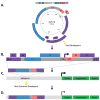Molecular mechanisms of human papillomavirus-related carcinogenesis in head and neck cancer
- PMID: 28619685
- PMCID: PMC5603399
- DOI: 10.1016/j.micinf.2017.06.001
Molecular mechanisms of human papillomavirus-related carcinogenesis in head and neck cancer
Abstract
This review examines the general cellular and molecular underpinnings of human papillomavirus (HPV)-related carcinogenesis in the context of head and neck squamous cell carcinoma (HNSCC) and focuses on HPV-positive oropharyngeal squamous cell carcinoma in areas for which specific data is available. It covers the major pathways dysregulated in HPV-positive HNSCC and the genome-wide changes associated with this disease.
Keywords: Chromatin; HNSCC; HPV; Oropharyngeal; Squamous cell carcinoma; Viral integration.
Copyright © 2017 Institut Pasteur. Published by Elsevier Masson SAS. All rights reserved.
Conflict of interest statement
The authors have no conflicts of interest to disclose.
Figures




References
-
- Global Burden of Disease Cancer C. Fitzmaurice C, Allen C, Barber RM, Barregard L, Bhutta ZA, et al. Global, Regional, and National Cancer Incidence, Mortality, Years of Life Lost, Years Lived With Disability, and Disability-Adjusted Life-years for 32 Cancer Groups, 1990 to 2015: A Systematic Analysis for the Global Burden of Disease Study. JAMA Oncol. 2017;3:524–548. - PMC - PubMed
-
- Carvalho AL, Nishimoto IN, Califano JA, Kowalski LP. Trends in incidence and prognosis for head and neck cancer in the United States: a site-specific analysis of the SEER database. Int J Cancer. 2005;114:806–16. - PubMed
-
- Tiwana MS, Wu J, Hay J, Wong F, Cheung W, Olson RA. 25 year survival outcomes for squamous cell carcinomas of the head and neck: population-based outcomes from a Canadian province. Oral Oncol. 2014;50:651–6. - PubMed
Publication types
MeSH terms
Grants and funding
LinkOut - more resources
Full Text Sources
Other Literature Sources
Medical

